IACS 国际船级社协会
- 格式:docx
- 大小:543.84 KB
- 文档页数:5
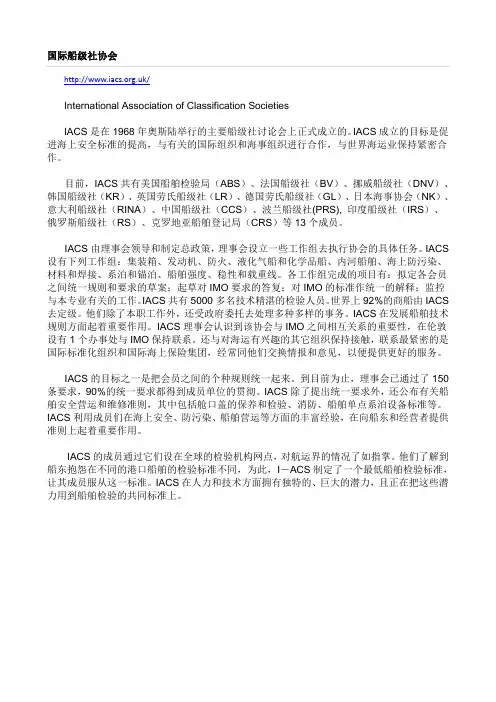
国际船级社协会/International Association of Classification Societies IACS 是在 1968 年奥斯陆举行的主要船级社讨论会上正式成立的。
IACS 成立的目标是促 进海上安全标准的提高,与有关的国际组织和海事组织进行合作,与世界海运业保持紧密合 作。
目前,IACS 共有美国船舶检验局(ABS)、法国船级社(BV)、挪威船级社(DNV)、 韩国船级社(KR)、英国劳氏船级社(LR)、德国劳氏船级社(GL)、日本海事协会(NK)、 意大利船级社(RINA)、中国船级社(CCS)、波兰船级社(PRS), 印度船级社(IRS)、 俄罗斯船级社(RS)、克罗地亚船舶登记局(CRS)等 13 个成员。
IACS 由理事会领导和制定总政策, 理事会设立一些工作组去执行协会的具体任务。
IACS 设有下列工作组:集装箱、发动机、防火、液化气船和化学品船、内河船舶、海上防污染、 材料和焊接、系泊和锚泊、船舶强度、稳性和载重线。
各工作组完成的项目有:拟定各会员 之间统一规则和要求的草案;起草对 IMO 要求的答复;对 IMO 的标准作统一的解释;监控 与本专业有关的工作。
IACS 共有 5000 多名技术精湛的检验人员。
世界上 92%的商船由 IACS 去定级。
他们除了本职工作外,还受政府委托去处理多种多样的事务。
IACS 在发展船舶技术 规则方面起着重要作用。
IACS 理事会认识到该协会与 IMO 之间相互关系的重要性,在伦敦 设有 1 个办事处与 IMO 保持联系。
还与对海运有兴趣的其它组织保持接触,联系最紧密的是 国际标准化组织和国际海上保险集团,经常同他们交换情报和意见,以便提供更好的服务。
IACS 的目标之一是把会员之间的个种规则统一起来。
到目前为止,理事会已通过了 150 条要求,90%的统一要求都得到成员单位的贯彻。
IACS 除了提出统一要求外,还公布有关船 舶安全营运和维修准则,其中包括舱口盖的保养和检验、消防、船舶单点系泊设备标准等。
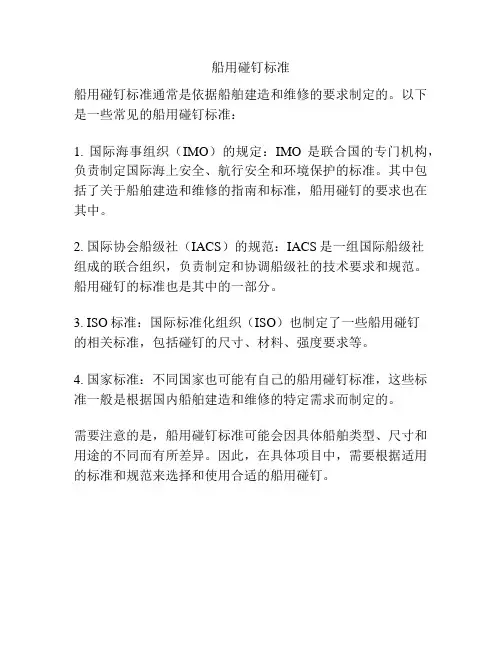
船用碰钉标准
船用碰钉标准通常是依据船舶建造和维修的要求制定的。
以下是一些常见的船用碰钉标准:
1. 国际海事组织(IMO)的规定:IMO是联合国的专门机构,负责制定国际海上安全、航行安全和环境保护的标准。
其中包括了关于船舶建造和维修的指南和标准,船用碰钉的要求也在其中。
2. 国际协会船级社(IACS)的规范:IACS是一组国际船级社
组成的联合组织,负责制定和协调船级社的技术要求和规范。
船用碰钉的标准也是其中的一部分。
3. ISO标准:国际标准化组织(ISO)也制定了一些船用碰钉
的相关标准,包括碰钉的尺寸、材料、强度要求等。
4. 国家标准:不同国家也可能有自己的船用碰钉标准,这些标准一般是根据国内船舶建造和维修的特定需求而制定的。
需要注意的是,船用碰钉标准可能会因具体船舶类型、尺寸和用途的不同而有所差异。
因此,在具体项目中,需要根据适用的标准和规范来选择和使用合适的船用碰钉。
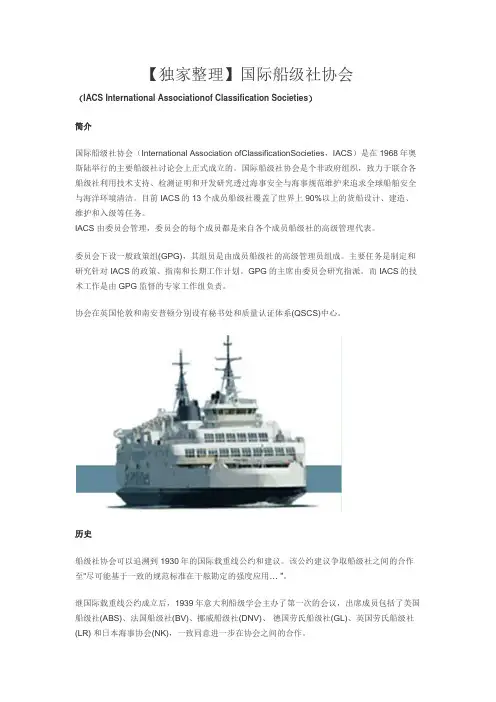
【独家整理】国际船级社协会(IACS International Associationof Classification Societies)简介国际船级社协会(International Association ofClassificationSocieties,IACS)是在1968年奥斯陆举行的主要船级社讨论会上正式成立的。
国际船级社协会是个非政府组织,致力于联合各船级社利用技术支持、检测证明和开发研究透过海事安全与海事规范维护来追求全球船舶安全与海洋环境清洁。
目前IACS的13个成员船级社覆盖了世界上90%以上的货船设计、建造、维护和入级等任务。
IACS 由委员会管理,委员会的每个成员都是来自各个成员船级社的高级管理代表。
委员会下设一般政策组(GPG),其组员是由成员船级社的高级管理员组成。
主要任务是制定和研究针对IACS的政策、指南和长期工作计划。
GPG的主席由委员会研究指派。
而IACS的技术工作是由GPG监督的专家工作组负责。
协会在英国伦敦和南安普顿分别设有秘书处和质量认证体系(QSCS)中心。
历史船级社协会可以追溯到1930年的国际载重线公约和建议。
该公约建议争取船级社之间的合作至"尽可能基于一致的规范标准在干舷勘定的强度应用… "。
继国际载重线公约成立后,1939年意大利船级学会主办了第一次的会议,出席成员包括了美国船级社(ABS)、法国船级社(BV)、挪威船级社(DNV)、德国劳氏船级社(GL)、英国劳氏船级社(LR) 和日本海事协会(NK),一致同意进一步在协会之间的合作。
1955年,第二次主要船级社间的会议召开,促进了专题工作组的成立。
随后在1968年成立了由7个主要的船级社组成的IACS。
刚成立的IACS在技术和经验水平的结合很快得到了业界的认同,并于1969年,成为了IMO的咨询组织。
它以非政府组织的观察身份得到了持续发展。
强制IACS成员船级社遵循IACS的质量认证体系(QSCS)。

混海事圈必须知道的十大海事组织一、国际海事组织关键词:IMO 联合国机构地球海事总局国际海事组织,简称IMO。
IMO始建于1959年,最初称为政府间海事协商组织,1982年改成现在的名,总部设在伦敦,是联合国的官方机构,相当于地球海事总局。
IMO作为联合国专门负责海事的官方机构,抓革命促生产当然不在话下,专门从事提高航行效率、防止海洋污染、统一法律适用等杂巴拉事。
总之是与海事相关的事,有人管的它管,没人管的它还管。
作为一个大名鼎鼎的国际组织,活儿再好也不可能面面俱到,所以,IMO最主要的工作表现为制定和修改国际公约。
《国际海上避碰规则公约》、《国际油污损害民事责任公约》、《海事索赔责任限制公约》这些个大牛的海事公约都是这家鼓捣出来的。
它们还会定期组织经验交流、分享情报信息,时不时给发展中国家弄点援助以扶持其航运业。
除此之外,总局也干点其他小活,比如搞个纪念日、评个先进人物啥的(官家都喜欢搞这些个虚招子)。
IMO规定了每年9月的最后一个星期,各成员国自选一天作为世界海事日,咋庆祝自己定,反正费用自理。
在这个问题上,咱大中国任了一把性,没按洋人划的圈走,愣把世界海事日和咱的中国航海日来了个强行捆绑,定在了每年的“7月11日”。
为啥是这一天尼?---咱郑大太监就是从600年前的7月11号起航下西洋的,有些历史学家说是其实是去帮朱棣找他的允文侄儿,一连去了七趟,看来这个朱棣是真心想他侄儿……二、国际海事委员会关键词:CMI 非政府促进海商法统一国际海事委员会,简称CMI。
国际海事委员会与国际海事组织都是海事口的大伽。
但前者是职能单一的非政府组织,后者是综合性的官方机构。
CMI于1897年创立于比利时安特卫普,宗旨是“促进海商法的统一”,由三十几个国家的国内海事委员会和由个人委员组成。
有两点值得注意:一方面,CMI要求入会的各国委员会制定的国内宗旨必须得和CMI宗旨相一致,体现了道不同不相为谋的理念;另一方面,它可以吸收个人会员,但必须得是海商法方面的专家,且由所在国家的海事委员会推荐。
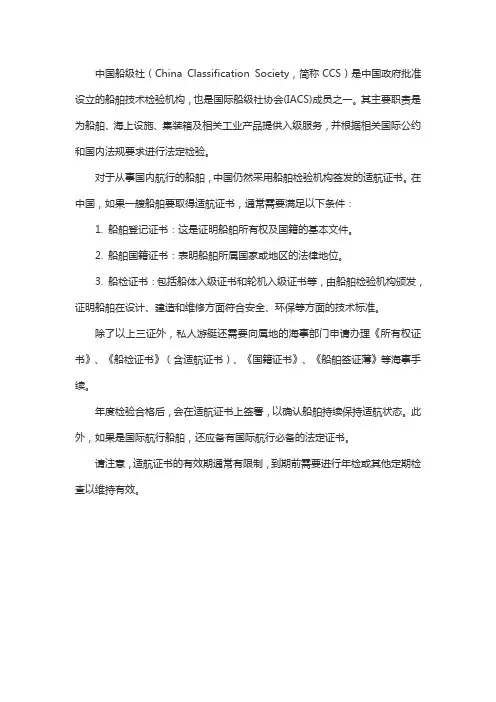
中国船级社(China Classification Society,简称CCS)是中国政府批准设立的船舶技术检验机构,也是国际船级社协会(IACS)成员之一。
其主要职责是为船舶、海上设施、集装箱及相关工业产品提供入级服务,并根据相关国际公约和国内法规要求进行法定检验。
对于从事国内航行的船舶,中国仍然采用船舶检验机构签发的适航证书。
在中国,如果一艘船舶要取得适航证书,通常需要满足以下条件:
1. 船舶登记证书:这是证明船舶所有权及国籍的基本文件。
2. 船舶国籍证书:表明船舶所属国家或地区的法律地位。
3. 船检证书:包括船体入级证书和轮机入级证书等,由船舶检验机构颁发,证明船舶在设计、建造和维修方面符合安全、环保等方面的技术标准。
除了以上三证外,私人游艇还需要向属地的海事部门申请办理《所有权证书》、《船检证书》(含适航证书)、《国籍证书》、《船舶签证薄》等海事手续。
年度检验合格后,会在适航证书上签署,以确认船舶持续保持适航状态。
此外,如果是国际航行船舶,还应备有国际航行必备的法定证书。
请注意,适航证书的有效期通常有限制,到期前需要进行年检或其他定期检查以维持有效。
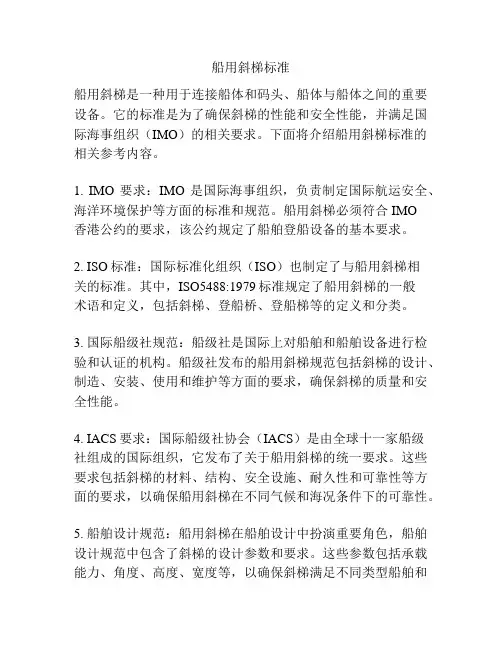
船用斜梯标准船用斜梯是一种用于连接船体和码头、船体与船体之间的重要设备。
它的标准是为了确保斜梯的性能和安全性能,并满足国际海事组织(IMO)的相关要求。
下面将介绍船用斜梯标准的相关参考内容。
1. IMO要求:IMO是国际海事组织,负责制定国际航运安全、海洋环境保护等方面的标准和规范。
船用斜梯必须符合IMO香港公约的要求,该公约规定了船舶登船设备的基本要求。
2. ISO标准:国际标准化组织(ISO)也制定了与船用斜梯相关的标准。
其中,ISO5488:1979标准规定了船用斜梯的一般术语和定义,包括斜梯、登船桥、登船梯等的定义和分类。
3. 国际船级社规范:船级社是国际上对船舶和船舶设备进行检验和认证的机构。
船级社发布的船用斜梯规范包括斜梯的设计、制造、安装、使用和维护等方面的要求,确保斜梯的质量和安全性能。
4. IACS要求:国际船级社协会(IACS)是由全球十一家船级社组成的国际组织,它发布了关于船用斜梯的统一要求。
这些要求包括斜梯的材料、结构、安全设施、耐久性和可靠性等方面的要求,以确保船用斜梯在不同气候和海况条件下的可靠性。
5. 船舶设计规范:船用斜梯在船舶设计中扮演重要角色,船舶设计规范中包含了斜梯的设计参数和要求。
这些参数包括承载能力、角度、高度、宽度等,以确保斜梯满足不同类型船舶和使用需求。
6. 国家标准:不同国家或地区也制定了船用斜梯的标准,如中国国家标准GB/T 14393-2008《船用斜梯技术条件》。
这些标准包括斜梯的制造材料、结构、尺寸、试验方法等方面的要求。
综上所述,船用斜梯的标准参考内容涵盖了IMO要求、ISO标准、国际船级社规范、IACS要求、船舶设计规范以及国家标准等。
这些参考内容确保了船用斜梯的性能和安全性能,以适应不同国家和地区、不同类型船舶的使用需求。
在设计、制造和安装船用斜梯时,应参考这些标准并进行相应的检验和认证,以确保斜梯的质量和可靠性。
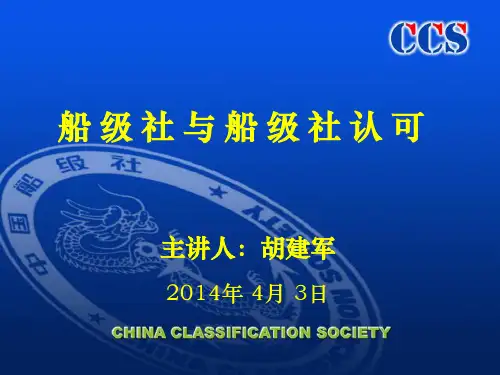

船级社认证国际船级社协会(International Association of Classification Societies,IACS)IACS是在1968年奥斯陆举行的主要船级社讨论会上正式成立的。
IACS成立的目标是促进海上安全标准的提高,与有关的国际组织和海事组织进行合作,与世界海运业保持紧密合作。
目前,IACS共有美国船舶检验局(ABS),法国船级社(BV),挪威船级社(DNV),韩国船级社(KR),英国劳氏船级社(LR),德国劳氏船级社(GR),日本海事协会(NK),波兰船舶登记局(PRS),意大利船级社(RINA)等11个正式成员和2个准会员。
中国船级社(CCS)于1988年加入IACS。
IACS由理事会领导和制定总政策,理事会设立一些工作组去执行协会的具体任务。
IACS设有下列工作组:集装箱、发动机、防火、液化气船和化学品船、内河船舶、海上防污染、材料和焊接、系泊和锚泊、船舶强度、稳性和载重线。
各工作组完成的项目有:拟定各会员之间统一规则和要求的草案;起草对IMO要求的答复;对IMO的标准作统一的解释;监控与本专业有关的工作。
IACS共有5000多名技术精湛的检验人员。
世界上92%的商船由IACS去定级。
他们除了本职工作外,还受政府委托去处理多种多样的事务。
IACS在发展船舶技术规则方面起着重要作用。
IACS理事会认识到该协会与IMO之间相互关系的重要性,在伦敦设有1个办事处与IMO保持联系。
还与对海运有兴趣的其它组织保持接触,联系最紧密的是国际标准化组织和国际海上保险集团,同他们交换情报和意见,以便提供更好的服务。
IACS的目标之一是要求把会员之间的个种规则统一起来。
到目前为止,理事会已通过了150条要求,90%的统一要求都得到成员单位的贯彻。
IACS除了提出统一要求外,还公布有关船舶安全营运和维修准则,其中包括舱口盖的保养和检验、消防、船舶单点系泊设备标准等。
IACS利用成员们在海上安全、防污染、船舶营运等方面的丰富经验,在向船东和经营者提供准则上起着重要作用。
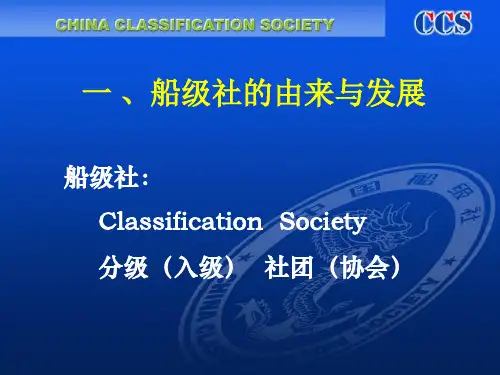
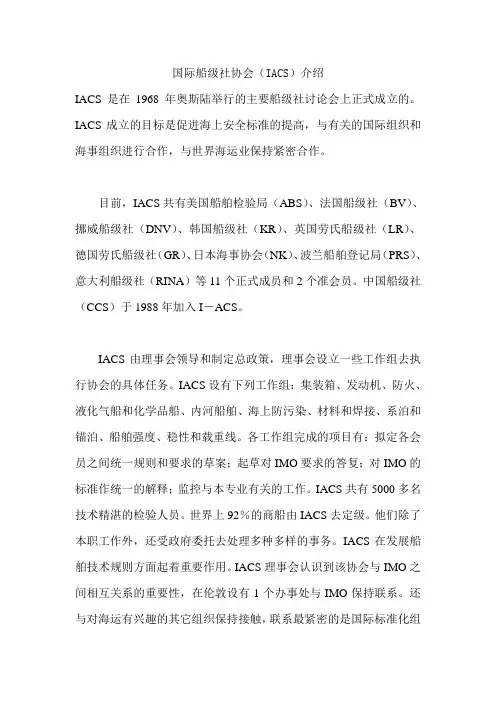
国际船级社协会(IACS)介绍IACS是在1968年奥斯陆举行的主要船级社讨论会上正式成立的。
IACS成立的目标是促进海上安全标准的提高,与有关的国际组织和海事组织进行合作,与世界海运业保持紧密合作。
目前,IACS共有美国船舶检验局(ABS)、法国船级社(BV)、挪威船级社(DNV)、韩国船级社(KR)、英国劳氏船级社(LR)、德国劳氏船级社(GR)、日本海事协会(NK)、波兰船舶登记局(PRS)、意大利船级社(RINA)等11个正式成员和2个准会员。
中国船级社(CCS)于1988年加入I-ACS。
IACS由理事会领导和制定总政策,理事会设立一些工作组去执行协会的具体任务。
IACS设有下列工作组:集装箱、发动机、防火、液化气船和化学品船、内河船舶、海上防污染、材料和焊接、系泊和锚泊、船舶强度、稳性和载重线。
各工作组完成的项目有:拟定各会员之间统一规则和要求的草案;起草对IMO要求的答复;对IMO的标准作统一的解释;监控与本专业有关的工作。
IACS共有5000多名技术精湛的检验人员。
世界上92%的商船由IACS去定级。
他们除了本职工作外,还受政府委托去处理多种多样的事务。
IACS在发展船舶技术规则方面起着重要作用。
IACS理事会认识到该协会与IMO之间相互关系的重要性,在伦敦设有1个办事处与IMO保持联系。
还与对海运有兴趣的其它组织保持接触,联系最紧密的是国际标准化组织和国际海上保险集团,经常同他们交换情报和意见,以便提供更好的服务。
IACS的目标之一是把会员之间的个种规则统一起来。
到目前为止,理事会已通过了150条要求,90%的统一要求都得到成员单位的贯彻。
IACS除了提出统一要求外,还公布有关船舶安全营运和维修准则,其中包括舱口盖的保养和检验、消防、船舶单点系泊设备标准等。
IACS利用成员们在海上安全、防污染、船舶营运等方面的丰富经验,在向船东和经营者提供准则上起着重要作用。
IACS的成员通过它们设在全球的检验机构网点,对航运界的情况了如指掌。
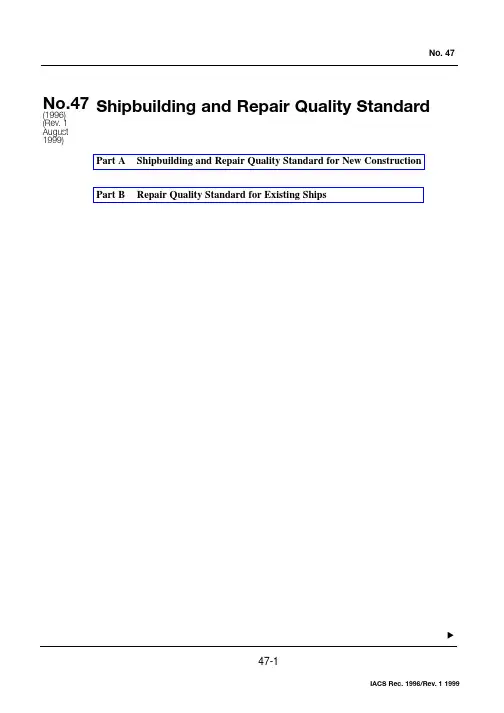
No. 4747-1IACS Rec. 1996/Rev. 1 1999IACS Copyright and Limited LiabilityClausesCopyright' IACS - the International Association of Classification Societies and the International Association of Classification Societies Limited (date)All rights reserved.Except as permitted under current English legislation no part of this work may be photocopied, stored in a retrieval system, published, performed in public, adapted, broadcast, transmitted, recorded or reproduced in any form or by means, without prior permission of the copyright owner.Where IACS has granted written permission for any part of this publication to be quoted such quotation must include acknowledgement to IACS.Enquiries should be addressed to the Permanent Secretary,International Association of Classification Societies Ltd,5 Old Queen StreetLondon, SW1H 9JATelephone: 020 7976 0660Fax:020 7976 0440Email:Permsec@(Additional, for Website:)With regard to information published on this website and where the copyrightresides with IACS and IACS Ltd., permission is hereby granted for use, as above. Terms and ConditionsThe International Association of Classification Societies (IACS), its Member Societies and IACS Ltd. and their directors, officers, members, employees and agents (on behalf of whom this notice is issued) shall be under no liability or responsibility in contract or negligence or otherwise howsoever to any person in respect of any information or advice expressly or impliedly given in this document, or in respect of any inaccuracy herein or omission herefrom or in respect of any act or omission which has caused or contributed to this document being issued with the information or advice it contains (if any).Without derogating from the generality of the foregoing, neither the International Association of Classification Societies (IACS) nor IACS Ltd. nor its Member Societies nor their directors, officers, members, employees or agents shall be liable in contract or negligence or otherwise howsoever for any direct, indirect or consequential loss to any person caused by or arising from any information, advice, inaccuracy or omission given or contained herein or any act or omission causing or contributing to any such information, advice, inaccuracy or omission given or contained herein.Any dispute concerning the provision of material herein is subject to the exclusive jurisdiction of the English courts and will be governed by English Law._______________________________________________________________________________________________________________________________________________________ Part A Shipbuilding and Repair Quality Standard for New Construction___________________________________________________________________________PART A - SHIPBUILDING AND REPAIR QUALITY STANDARDS FOR NEW CONSTRUCTION1. Scope2. General requirements for new construction3. Qualification of personnel and procedures3.1 Qualification of welders3.2 Approval of welding procedures3.3 Qualification of NDE operators4. Materials4.1 Materials for structural members4.2 Under thickness tolerances4.3 Surface conditions5. Cutting5.1 Gas cutting5.2 Plasma arc cutting5.3 Laser beam cutting6. Fabrication and fairness6.1 Flange longitudinals and flange brackets6.2 Built-up sections6.3 Corrugated bulkheads6.4 Pillars, brackets and stiffeners6.5 Maximum heating temperature on surface for line heating6.6 Block assembly6.7 Special sub-assembly6.8 Shape6.9 Fairness of plating between frames6.10 Fairness of plating with frames7. Alignment8. Welding8.1 Typical butt weld plate edge preparation (manual welding)8.2 Typical fillet weld plate edge preparation (manual welding)8.3 Typical butt and fillet weld profile (manual welding)8.4 Lap, plug and slot welding8.5 Distance between welds8.6 Automatic welding9. Repair9.1 Typical misalignment repair9.2 Typical butt weld plate edge preparation repair (manual welding)9.3 Typical fillet weld plate edge preparation repair (manual welding)9.4 Typical fillet and butt weld profile repair (manual welding)9.5 Distance between welds repair9.6 Erroneous hole repair9.7 Repair by insert plate9.8 Weld surface repairREFERENCES1. IACS “Bulk Carriers - Guidelines for Surveys, Assessment and Repair of Hull Structure”2. TSCF “Guidelines for the inspection and maintenance of double hull tanker structures”3. TSCF “Guidance manual for the inspection and condition assessment of tanker structures”4. IACS UR W7 “Hull and machinery steel forgings”5. IACS UR W8 “Hull and machinery steel castings”6. IACS UR W11 “Normal and higher strength hull structural steel”7. IACS UR W13 “Allowable under thickness tolerances of steel plates and wide flats”8. IACS UR W14 “Steel plates and wide flats with improved through thickness properties”9. IACS UR W17 “Approval of consummables for welding normal and higher strength hull structural steels”10. IACS UR Z10.1 “Hull surveys of oil tankers”and Z10.2 “Hull surveys of bulk carriers” Annex I11. IACS Recommendation No. 12 “Guidelines for surface finish of hot rolled plates and wide flats “13. IACS Recommendation No. 20 “ Guide for inspection of ship hull welds”1. Scope1.1 This standard provides guidance on shipbuilding quality standards for the hull structure during new construction and the repair standard where the quality standard is not met.Whereas the standard generally applies to- conventional ship types,- parts of hull covered by the rules of the Classification Society,- hull structures constructed from normal and higher strength hull structural steel,the applicability of the standard is in each case to be agreed upon by the Classification Society.The standard does generally not apply to the new construction of- special types of ships as e.g. gas tankers- structures fabricated from stainless steel or other, special types or grades of steel1.2 The standard covers typical construction methods and gives guidance on quality standards for the most important aspects of such construction. Unless explicitly stated elsewhere in the standard, the level of workmanship reflected herein will in principle be acceptable for primary and secondary structure of conventional designs. A more stringent standard may however be required for critical and highly stressed areas of the hull, and this is to be agreed with the Classification Society in each case. In assessing the criticality of hull structure and structural components, reference is made to ref. 1, 2 and 3.1.3 Details relevant to structures or fabrication procedures not covered by this standard are to be approved by the Classification Society on the basis of procedure qualifications and/or recognised national standards.1.4 It is intended that these standards provide guidance where established shipbuilding or national standards approved by the Classification Society do not exist.1.5 For use of this standard, fabrication fit-ups, deflections and similar quality attributes are intended to be uniformly distributed about the nominal values. The shipyard is to take corrective action to improve work processes that produce measurements where a skewed distribution is evident. Relying upon remedial steps that truncate a skewed distribution of the quality attribute is unacceptable.2. General requirements for new construction2.1 In general, the work is to be carried out in accordance with the Classification Society Rules and under the supervision of the Surveyor to the Classification Society2.2 Provisions are to be made for proper accessibility, staging, lighting and ventilation. Welding operations are to be carried out under shelter from rain, snow and wind.2.3 Welding of hull structures is to be carried out by qualified welders, according to approved and qualified welding procedures and with welding consumables approved by the Classification Society, see Section3. Welding operations are to be carried out under proper supervision by the shipbuilder.3. Qualification of personnel and procedures3.1 Qualification of welders3.1.1 Welders are to be qualified in accordance with the procedures of the Classification Society or to a recognised national or international standard, e.g. EN 287, ISO 9606, ASME Section IX, ANSI/AWS D1.1. Recognition of other standards is subject to submission to the Classification Society for evaluation. Subcontractors are to keep records of welders qualification and, when required, furnish valid approval test certificates.3.1.2 Welding operators using fully mechanised or fully automatic processes need generally not pass approval testing provided that the production welds made by the operators are of the required quality. However, operators are to receive adequate training in setting or programming and operating the equipment Records of training and production test results shall be maintained on individual operator’s files and records, and be made available to the Classification Society for inspection when requested.3.2 Qualification of welding proceduresWelding procedures are to be qualified in accordance with the procedures of the Classification Society or a recognised national or international standard, e.g. EN288, ISO 9956, ASME Section IX, ANSI/AWS D1.1. Recognition of other standards is subject to submission to the Classification Society for evaluation. The welding procedure should be supported by a welding procedure qualification record. The specification is to include the welding process, types of electrodes, weld shape, edge preparation, welding techniques and positions.3.3 Qualification of NDE operators3.3.1 Personnel performing non-destructive examination for the purpose of assessing quality of welds in connection with new construction covered by this standard, are to be qualified in accordance with Classification Society rules or to a recognised international or national qualification scheme. Records of operators and their current certificates are to be kept and made available to the Surveyor for inspection.4.Materials4.1Materials for Structural MembersAll materials, including weld consummables, to be used for the structural members are to be approved by the Classification Society as per the approved construction drawings and meet the respective IACS Unified Requirements. Additional recommendations are contained in the following paragraphs.All materials used should be manufactured at a works approved by the Classification Society for the type and grade supplied.4.2Under Thickness TolerancesThe maximum permissible under thickness tolerance, for hull structural plates and wide flats with thicknesses of 5mm and over, for both normal and high strength steels, is -0.3mm.The thickness is to be measured at random locations whose distance from an edge shall be at least 10mm. Local surface depressions resulting from imperfections and ground areas resulting from the elimination of defects may be disregarded provided the imperfections or grinding are in accordance with the requirements of Section 4.3 “Surface Conditions”.4.3Surface Conditions4.3.1DefinitionsMinor Imperfections:pittings, rolled-in scale, indentations, roll marks, scratches andgroovesDefects:Cracks, shells, sand patches, sharp edged seams and minorimperfections not exceeding the limits of table 1 in case that thesum of the influenced area exceeds 5% of the total surfacein questionDepth of Imperfections or defects: the depth is to be measured from the surface ofthe product4.3.2Unrepaired ConditionsMinor imperfections, in accordance with the limits described in Table 1, are permissible and may be left unrepaired.4.3.3Repairs of DefectsDefects are to be repaired by grinding or welding irrespective of their size and number. Repair by grinding may be carried out over the entire surface up to a depth equal to the under thickness tolerances given in para.4.2.The sum of the repairs by welding and of the repairs by grinding, reducing the nominal thickness by more than 0.3mm, shall not exceed 2% of the total surface in question.4.3.4Repairs by GrindingFor ground areas with a thickness less than the minimum permissible thickness stated in para.4.2, the nominal thickness is not to be reduced by more than 7% or 3mm, whichever is the lesser. Each single ground area is not to exceed 0.25m2.The defects are to be completely removed by grinding. Complete elimination of the defects is to be verified by a magnetic particle or dye penetrant test procedure. The ground areas must have smooth transitions to the surrounding surface.4.3.5Repairs by weldingLocal defects, which cannot be repaired by grinding, may be repaired by chipping and/or grinding followed by welding in accordance with the qualified procedures approved by the Classification Society concerned.Any single welded area is not to exceed 0.125m2. The weld preparation should not reduce the thickness of the product below 80% of the nominal thickness. Welding is to be completed with one layer of weld bead in excess, which is subsequently to be ground smooth, level with the plate surface. The soundness of the repair is to be verified by ultrasonic, magnetic particle or dye penetrant methods.Table 1 Limits for minor imperfections left unrepaired4.3.6Further Defects4.3.6.1LaminationInvestigation to be carried out at the steelmill into the cause and extent of the laminations. Severe lamination is to be repaired by a local insert plates. The minimum breadth of the plate to be repaired by insert is to be:• 1600mm for shell and strength deck plating in way of cruciform or T-joints,• 800mm for shell, strength deck plating and other primary members,• 300mm for other structural members.Local limited lamination may be repaired by chipping and/or grinding followed by welding in accordance with sketch (a). In case where the local limited lamination is near the plate surface, the repair may be carried out as shown in sketch (b). For limitations see paragraph 4.3.5.(b)4.3.6.2Weld SpattersLoose weld spatters are to be removed completely by grinding to clean metal (see Table 9.13) on:• shell plating• deck plating on exposed decks• in tanks for chemical cargoes• in tanks for fresh water and for drinking water• in tanks for lubricating oil, hydraulic oil, including service tanks5.Cutting5.1Gas CuttingThe deviation u of cut edges (see sketch (a)), from a right angle or from a required slope, and the roughness of the cut edges R, is to meet the following requirements:Mechanised Gas Cutting Manual Gas Cutting: Free EdgesCut Thickness Standard Limit Strength Members Standard Limita≤20mm u=0.6mm u=1.2mm u=1.5mm u=1.5mm R=100µm R=150µm R=150µm R=300µmOthersa>20mm u=0.75mm u=1.5mm u=1.5mm u=1.5mmR-100µm R=150µm R=300µm R=500µmManual Gas Cutting: Welding EdgesStandard LimitStrength Members u=1.5mm u=1.5mmR=400µm R=800µm*Others u=1.5mm u=1.5mmR=800µm*R=1500µm*Individual non-sharp notches caused by torch failures (scouring) are not to be greater than 3mm in depth. Deeper scores should be removed by grinding.* Unless the welding procedure needs smaller tolerances.(a) deviation u from a right angle or from a required slope5.2Plasma Arc CuttingThe deviation u of the cut edge (see sketch (a)), from a right angle or from a required slope, and the roughness of the cut edge R, is to meet the following requirements:Mechanised Plasma Arc CuttingCut Thickness Standard Limita≤20mm u=1.0mm u=1.5mmR=100µm R=150µma>20mm u=0.75mm u=1.5mmR=100µm R=150µmThe tolerances for manual cutting are to be agreed by the Classification Society concerned.5.3Laser Beam CuttingThe standard range and the tolerance limits for the deviation from a right angle or from a required slope of the cut edges and the roughness of the cut edges are to be agreed by the Classification Society concerned.6. Fabrication and fairness6.1 Flanged longitudinals and flanged brackets (see Table 6.1)6.2 Built-up sections (see Table 6.2)6.3 Corrugated bulkheads (see Table 6.3)6.4 Pillars, brackets and stiffeners (see Table 6.4)6.5 Maximum heating temperature on surface for line heating (see Table 6.5)6.6Block assembly (see Table 6.6)6.7 Special sub-assembly (see Table 6.7)6.8 Shape (see Table 6.8 and 6.9)6.9 Fairness of plating between frames (see Table 6.10)6.10 Fairness of plating with frames (see Table 6.11)7. AlignmentThe quality standards for alignment of hull structural components during new construction are shown in Tables 7.1, 7.2 and 7.3. The classification society may require a closer construction tolerance in areas requiring special attention, as follows:• Regions exposed to high stress concentrations• Fatigue prone areas• Detail design block erection joints• Higher tensile steel regions8. Welding Details8.1 Typical butt weld plate edge preparation (manual welding) - see Table 8.1 and 8.28.2 Typical fillet weld plate edge preparation (manual welding) - see Table 8.3 and 8.48.3 Typical butt and fillet weld profile (manual welding) - see Table 8.58.4 Lap, plug and slot welding - see Table 8.68.5 Distance between welds - see Table 8.78.6 Automatic welding - see Table 8.89. Repair9.1 Typical misalignment repair - see Tables 9.1 to 9.39.2 Typical butt weld plate edge preparation repair (manual welding) - see Table 9.4 and 9.59.3 Typical fillet weld plate edge preparation repair (manual welding) - see Tables 9.6 to 9.89.4 Typical fillet and butt weld profile repair (manual welding) - see Table 9.99.5 Distance between welds repair - see Table 9.109.6 Erroneous hole repair - see Table 9.119.7 Repair by insert plate - see Table 9.129.8 Weld surface repair - see Table 9.13TABLE 6.1 - FLANGED LONGITUDINALS AND BRACKETSTABLE 6.2 - BUILT UP SECTIONSTABLE 6.3 - CORRUGATED BULKHEADSTABLE 6.4 - PILLARS, BRACKETS AND STIFFENERSTABLE 6.5 - MAXIMUM HEATING TEMPERATURE ON SURFACE FORTABLE 6.8 - SHAPETABLE 8.4 - TYPICAL FILLET WELD PLATE EDGE PREPARATION (MANUAL WELDING)TABLE 8.5 -TYPICAL BUTT AND FILLET WELD PROFILE (MANUAL WELDING)TABLE 8.6 -TYPICAL LAP, PLUG AND SLOT WELDING (MANUAL WELDING)No. 47IACS Rec. 1996/Rev. 1 1999TABLE 8.8 - AUTOMATIC ARC WELDINGTABLE 9.3 - MISALIGNMENT REPAIRTABLE 9.8 -TYPICAL FILLET WELD PLATE EDGE PREPARATION REPAIR (MANUAL WELDING)TABLE 9.9 - TYPICALFILLET AND BUTT WELD PROFILE REPAIR (MANUAL WELDING)TABLE 9.10 - DISTANCE BETWEEN WELDS REPAIRTABLE 9.11 - ERRONEOUS HOLE REPAIRTABLE 9.12 - REPAIR BY INSERT PLATETABLE 9.13 - WELD SURFACE REPAIR___________________________________________________________________________ Part B Repair Quality Standard for Existing Ships___________________________________________________________________________PART B -SHIPBUILDING AND REPAIR QUALITY STANDARD FOR EXISTING SHIPSC ONTENTS:1. Scope2. General requirements to repairs and repairers3. Qualification of personnel3.1 Qualification of welders3.2 Qualification of welding procedures3.3 Qualification of NDE operators4. Materials4.1 General requirements to materials4.2 Equivalency of material grades5. General requirements to welding5.1 Correlation of welding consumables to hull structural steels5.2 General requirements to preheating and drying out5.3 Dry welding on hull plating below the waterline of vessels afloat6. Repair quality standard6.1 Welding, general6.2 Renewal of plates6.3 Doubler on plates6.4 Renewal of internals/stiffeners6.5 Renewal of internals/stiffeners - transitions inverted angles/bulb profiles6.6 Termination of straps6.7 Welding of pitting corrosion6.8 Welding repairs of cracks6.9 Grinding of shallow cracksREFERENCES1. IACS “Bulk Carriers - Guidelines for Surveys, Assessment and Repair of Hull Structure”2. TSCF “Guidelines for the inspection and maintenance of double hull tanker structures”3. TSCF “Guidance manual for the inspection and condition assessment of tanker structures”4. IACS UR W 11 “Normal and higher strength hull structural steels”5. IACS UR W 13 “Allowable under thickness tolerances of steel plates and wide flats”6. IACS UR W 17 “Approval of consumables for welding normal and higher strength hull structural steels”7. IACS Z 10.1 “Hull surveys of oil tankers” and Z 10.2 “Hull surveys of bulk carriers” Table IV8. IACS UR Z 13 “Voyage repairs and maintenance”9. IACS Recommendation 12 “Guidelines for surface finish of hot rolled steel plates and wide flats”10. IACS Recommendation 20 “Guide for inspection of ship hull welds”1. Scope1.1 This standard provides guidance on quality of repair of hull structures. The standard covers permanent repairs of existing ships.Whereas the standard generally applies to- conventional ship types,- parts of hull covered by the rules of the Classification Society,- hull structures constructed from normal and higher strength hull structural steel,the applicability of the standard is in each case to be agreed upon by the Classification Society.The standard does generally not apply to repair of- special types of ships as e.g. gas tankers- structures fabricated from stainless steel or other, special types or grades of steel1.2 The standard covers typical repair methods and gives guidance on quality standard on the most important aspects of such repairs. Unless explicitly stated elsewhere in the standard, the level of workmanship reflected herein will in principle be acceptable for primary and secondary structure of conventional design. A more stringent standard may however be required for critical and highly stressed areas of the hull, and is to be agreed with the Classification Society in each case. In assessing the criticality of hull structure and structural components, reference is made to ref. 1, 2 and 3.1.3 Restoration of structure to the original standard may not constitute durable repairs of damages originating from insufficient strength or inadequate detail design. In such cases strengthening or improvements beyond the original design may be required. Such improvements are not covered by this standard, however it is referred to ref. 1, 2 and 3.2. General requirements for repairs and repairers2.1 In general, when hull structure covered by classification is to be subjected to repairs, the work is to be carried out under the supervision of the Surveyor to the Classification Society. Such repairs are to be agreed prior to commencement of the work.2.2 Repairs are to be carried out by workshops, repair yards or personnel who have demonstrated their capability to carry out hull repairs of adequate quality in accordance with the Classification Society’s requirements and this standard.2.3 Repairs are to be carried out under working conditions that facilitate sound repairs. Provisions are to be made for proper accessibility, staging, lighting and ventilation. Welding operations are to be carried out under shelter from rain, snow and wind.2.4 Welding of hull structures is to be carried out by qualified welders, according to approved and qualified welding procedures and with welding consumables approved by the Classification Society, see Section3. Welding operations are to be carried out under proper supervision of the repair yard.2.5 Where repairs to hull which affect or may affect classification are intended to be carried out during a voyage, complete repair procedure including the extent and sequence of repair is to be submitted to and agreed upon by the Surveyor to the Classification Society reasonably in advance of the repairs. See Ref. 8.3. Qualification of personnel3.1 Qualification of welders3.1.1 Welders are to be qualified in accordance with the procedures of the Classification Society or to a recognised national or international standard, e.g. EN 287, ISO 9606, ASME Section IX, ANSI/AWS D1.1. Recognition of other standards is subject to submission to the Classification Society for evaluation. Repair yards and workshops are to keep records of welders qualification and, when required, furnish valid approval test certificates.3.1.2 Welding operators using fully mechanised of fully automatic processes need generally not pass approval testing, provided that production welds made by the operators are of the required quality. However, operators are to receive adequate training in setting or programming and operating the equipment. Records of training and production test results shall be maintained on individual operator’s files and records, and be made available to the Classification Society for inspection when requested.3.2 Qualification of welding proceduresWelding procedures are to be qualified in accordance with the procedures of the Classification Society or a recognised national or international standard, e.g. EN288, ISO 9956, ASME Section IX, ANSI/AWS D1.1. Recognition of other standards is subject to submission to the Classification Society for evaluation. The welding procedure should be supported by a welding procedure qualification record. The specification is to include the welding process, types of electrodes, weld shape, edge preparation, welding techniques and positions3.3 Qualification of NDE operators3.3.1 Personnel performing non destructive examination for the purpose of assessing quality of welds in connection with repairs covered by this standard, are to be qualified in accordance with the Classification Society rules or to a recognised international or national qualification scheme. Records of operators and their current certificates are to be kept and made available to the Surveyor for inspection.4. Materials4.1. General requirements for materials4.1.1 The requirements for materials used in repairs are in general the same as the requirements for materials specified in the Classification Society’s rules for new constructions, (ref. 5)4.1.2 Replacement material is in general to be of the same grade as the original approved material. Alternatively, material grades complying with recognised national or international standards may be accepted by the Classification Societies provided such standards give equivalence to the requirements of the original grade or are agreed by the Classification Society. For assessment of equivalency between steel grades, the general requirements and guidelines in Section 4.2 apply.4.1.3 Higher tensile steel is not to be replaced by steel of a lesser strength unless specially approved by the Classification Society.4.1.4 Normal and higher strength hull structural steels are to be manufactured at works approved by the Classification Society for the type and grade being supplied.4.1.5 Materials used in repairs are to be certified by the Classification Society applying the procedures and requirements in the rules for new constructions. In special cases, and normally limited to small quantities, materials may be accepted on the basis of alternative procedures for verification of the material’s properties. Such procedures are subject to agreement by the Classification Society in each separate case.4.2. Equivalency of material grades4.2.1 Assessment of equivalency between material grades should at least include the following aspects;- heat treatment/delivery condition- chemical composition- mechanical properties- tolerances4.2.2 When assessing the equivalence between grades of normal or higher strength hull structural steels up to and including grade E40 in thickness limited to 50 mm, the general requirements in Table 4.1 apply.4.2.3 Guidance on selection of steel grades to certain recognised standards equivalent to hull structural steel grades specified in Classification Societies’ rules is given in Table 4.25. General requirements to welding5.1 Correlation of welding consumables with hull structural steels5.1.1 For the different hull structural steel grades welding consummables are to be selected in accordance with IACS UR W17 (see Ref.5).5.2 General requirements to preheating and drying out5.2.1 The need for preheating is to be determined based on the chemical composition of the materials, welding process and procedure and degree of joint restraint.5.2.2 A minimum preheat of 50o C is to be applied when ambient temperature is below 0°C. Dryness of the welding zone is in all cases to be ensured.。
检验专业委员会主席的引导和组织协调作用,与IACS各成
导则等重点领域,开展了大量卓有成效的工作,并加强了与国
13500TEU集装箱船
“中远海运兰花”号命名交付
对船舶能效状况、航行及装载状态等进行评估,并通过大数据分析及优化技术,为船舶提供数据评估分析结果和辅助决策建议,实现对船舶能效实时监控、智能评估及优化,以不断提高船舶能效管理水平,使得该船的节能减排能力和经济效益提升到一个崭新的高度。
同时,该船采用了船体结构建造监控和TOFD-PAUT联合检测等先进的建造和检验技术,大幅提高了建造精度和船舶建造质量,有效增加了船舶的营运寿命。
国际船级社协会介绍
国际船级社协会(IACS)是一个由12个国际知名的船级社组成的国际
组织。
它成立于1968年,总部位于伦敦,是全球最大和最重要的海事技
术标准制定组织之一、IACS的12个成员船级社分布在世界各地,包括美国、日本、中国、韩国、德国、英国、荷兰、法国、挪威、瑞典和意大利。
IACS的使命是通过制定海事技术标准和提供技术服务,确保全球船
舶和海上设施的安全、可靠和环保。
作为船级社的国际联盟,IACS的成
员共同合作,分享经验和专业知识,并通过研究和技术创新来推动航运行
业的发展。
为了提高船舶的可靠性和安全性,IACS的成员船级社持续进行技术
研究和创新。
他们关注新船舶建造技术、船舶性能评估、海事环境保护和
风险评估等领域的发展。
IACS的技术研究成果被应用于船舶建造、设计
和运营中,以提高船舶的性能和效率,并保证海上交通的安全。
除了技术研究和服务,IACS也致力于促进全球航运行业的可持续发展。
他们支持国际海事组织(IMO)制定的规章制度,推动全球航运行业的
环境可持续性和社会责任。
IACS还与不同的国际组织和机构合作,共同
解决航运行业面临的挑战,包括海事安全、海洋污染和气候变化等问题。
总之,国际船级社协会(IACS)是一个由12个国际知名的船级社组成
的国际组织。
它在全球航运行业中发挥着重要的作用,通过制定技术标准
和提供技术服务,确保船舶和海上设施的安全、可靠和环保。
同时,IACS
也促进航运行业的可持续发展,并与其他国际组织合作解决行业面临的挑战。
国际船级社协会(IACS International Association of Classification Societies)简介国际船级社协会(InternationalAssociation of ClassificationSocieties,IACS)是在1968年奥斯陆举行的主要船级社讨论会上正式成立的。
国际船级社协会是个非政府组织,致力于联合各船级社利用技术支持、检测证明和开发研究透过海事安全与海事规范维护来追求全球船舶安全与海洋环境清洁。
目前IACS的13个成员船级社覆盖了世界上90%以上的货船设计、建造、维护和入级等任务。
IACS 由委员会管理,委员会的每个成员都是来自各个成员船级社的高级管理代表。
委员会下设一般政策组(GPG),其组员是由成员船级社的高级管理员组成。
主要任务是制定和研究针对IACS的政策、指南和长期工作计划。
GPG的主席由委员会研究指派。
而IACS的技术工作是由GPG 监督的专家工作组负责。
协会在英国伦敦和南安普顿分别设有秘书处和质量认证体系(QSCS)中心。
历史船级社协会可以追溯到1930年的国际载重线公约和建议。
该公约建议争取船级社之间的合作至"尽可能基于一致的规范标准在干舷勘定的强度应用…"。
继国际载重线公约成立后,1939年意大利船级学会主办了第一次的会议,出席成员包括了美国船级社(ABS)、法国船级社(BV)、挪威船级社(DNV)、德国劳氏船级社(GL)、英国劳氏船级社(LR) 和日本海事协会(NK),一致同意进一步在协会之间的合作。
1955年,第二次主要船级社间的会议召开,促进了专题工作组的成立。
随后在1968年成立了由7个主要的船级社组成的IACS。
刚成立的IACS在技术和经验水平的结合很快得到了业界的认同,并于1969年,成为了IMO的咨询组织。
它以非政府组织的观察身份得到了持续发展。
强制IACS成员船级社遵循IACS的质量认证体系(QSCS)。
国际船级社协会(IACS)介绍IACS是在1968年奥斯陆举行的主要船级社讨论会上正式成立的。
IACS成立的目标是促进海上安全标准的提高,与有关的国际组织和海事组织进行合作,与世界海运业保持紧密合作。
目前,IACS共有美国船舶检验局(ABS)、法国船级社(BV)、挪威船级社(DNV)、韩国船级社(KR)、英国劳氏船级社(LR)、德国劳氏船级社(GR)、日本海事协会(NK)、波兰船舶登记局(PRS)、意大利船级社(RINA)等11个正式成员和2个准会员。
中国船级社(CCS)于1988年加入I-ACS。
IACS由理事会领导和制定总政策,理事会设立一些工作组去执行协会的具体任务。
IACS设有下列工作组:集装箱、发动机、防火、液化气船和化学品船、内河船舶、海上防污染、材料和焊接、系泊和锚泊、船舶强度、稳性和载重线。
各工作组完成的项目有:拟定各会员之间统一规则和要求的草案;起草对IMO要求的答复;对IMO的标准作统一的解释;监控与本专业有关的工作。
IACS共有5000多名技术精湛的检验人员。
世界上92%的商船由IACS去定级。
他们除了本职工作外,还受政府委托去处理多种多样的事务。
IACS在发展船舶技术规则方面起着重要作用。
IACS理事会认识到该协会与IMO之间相互关系的重要性,在伦敦设有1个办事处与IMO保持联系。
还与对海运有兴趣的其它组织保持接触,联系最紧密的是国际标准化组织和国际海上保险集团,经常同他们交换情报和意见,以便提供更好的服务。
IACS的目标之一是把会员之间的个种规则统一起来。
到目前为止,理事会已通过了150条要求,90%的统一要求都得到成员单位的贯彻。
IACS除了提出统一要求外,还公布有关船舶安全营运和维修准则,其中包括舱口盖的保养和检验、消防、船舶单点系泊设备标准等。
IACS利用成员们在海上安全、防污染、船舶营运等方面的丰富经验,在向船东和经营者提供准则上起着重要作用。
IACS的成员通过它们设在全球的检验机构网点,对航运界的情况了如指掌。
国际船级社协会
(IACS International Association of Classification Societies)
简介
国际船级社协会(International
Association of Classification
Societies,IACS)是在1968年奥
斯陆举行的主要船级社讨论会上正
式成立的。
国际船级社协会是个非政
府组织,致力于联合各船级社利用技
术支持、检测证明和开发研究透过海
事安全与海事规范维护来追求全球
船舶安全与海洋环境清洁。
目前IACS的13个成员船级社覆盖了世界上90%以上的货船设计、建造、维护和入级等任务。
IACS 由委员会管理,委员会的每个成员都是来自各个成员船级社的高级管理代表。
委员会下设一般政策组(GPG),其组员是由成员船级社的高级管理员组成。
主要任务是制定和研究针对IACS的政策、指南和长期工作计划。
GPG的主席由委员会研究指派。
而IACS的技术工作是由GPG 监督的专家工作组负责。
协会在英国伦敦和南安普顿分别设有秘书处和质量认证体系(QSCS)中心。
历史
船级社协会可以追溯到1930年的国际载重线公约和建议。
该公约建议争取船级社之间的合作至"尽可能基于一致的规范标准在干舷勘定的强度应用…"。
继国际载重线公约成立后,1939年意大利船级学会主办了第一次的会议,出席成员包括了美国船级社(ABS)、法国船级社(BV)、挪威船级社(DNV)、德国劳氏船级社(GL)、英国劳氏船级社(LR) 和日本海事协会(NK),一致同意进一步在协会之间的合作。
1955年,第二次主要船级社间的会议召开,促进了专题工作组的成立。
随后在1968年成立了由7个主要的船级社组成的IACS。
刚成立的IACS在技术和经验水平的结合很快得到了业界的认同,并于1969年,成为了IMO的咨询组织。
它以非政府组织的观察身份得到了持续发展。
强制IACS成员船级社遵循IACS的质量认证体系(QSCS)。
船级社的产生
船级社最早产生于二百三十多年前的英国。
十八世纪中,英国伦敦泰晤士河畔设有若干的咖啡馆,从事船舶生意的人们常在此聚谈,其中营业最盛者是爱德华·劳埃德咖啡馆,因此所有船舶和货物保险,大部分均在该咖啡馆办理,于是形成了海上保险的中心。
由于保险需要了解船舶的技术状况,遂于1760年成立了劳埃德船级社,并开始实施船舶检验和登记入级。
初期的验船师大多是退休的船长和船上的木匠,经验丰富,一验便知船舶优劣(那时都是木帆船)。
最初他们把船体技术状况划分为五类:A(最好)、E(较好)、I(中等)、O(较坏)、U(最坏);又将所备帆、锚等设备分为三类:G(好)、M(中)、B(坏)。
后
来逐步根据需要,变革到现在的入级符
号。
Classification一词原是分级的意思,
现在成为入级,不在对船舶划分等级。
只要船舶建造符合船级社的建造规范,
并经检验合格,该船即可在该船级社入
级。
劳氏船级社成立以后,鉴于船级社
的作用和实际需要,各航运发达国家、
以及有些发展中国家,也相继成立了自
己的船级机构,以便发展航运事业和增
强国际竞争能力。
迄今世界上已有近
50家船级社。
随着专业分级的介入,除了一些例外,不同的分级已经被取代。
现在的船舶至少符合相关船级社标准的一种,所以只分为符合和不符合标准。
但是,每个船级社都发展了一系列的船舶标记来表明该船舶是符合一些额外的特定船型或者超过船级社要求的志愿标准。
船级
船级是评定船舶技术状况的国际通用形式,是由验船师或船级社检验后根据船舶的用途、技术状况和航行区域等授予的技术级别。
船舶入级后,可凭此向保险公司办理各种保险。
船舶入级的情况是保险公司考虑承保和确定保险率的必要条件。
船级检验
船级检验是指根据船级社验船技术规范标准进行检验并签发船级证书的检验。
船级检验属于自愿性质,由船东选择船级社进行。
根据建造期间的设计和检验的满意度确定船舶的指定等级,目的是为了验证船舶建造符合船级社的标准。
对于现有的船舶,如果想要从一个认证船级社转移到另一个船级社需要采用具体的程序。
船舶要是一直保留原有的认证船级社就必须受限于该船级社的终生检验规范。
这些检验包括:特别检验(Special
Survey)、中间检验(Intermediate Survey)、
年度检验(Annual Survey),坞内检验
(Docking Survey)。
同时还包含:螺旋
桨轴和尾管轴检验(Screw Shaft and
Tube Shaft Survey)、锅炉和热油加热器
检验(Boiler Survey,Survey of Thermal
oil Units)、循环检验(Continuous
Machinery Survey—CMS)、损坏和修理
检验(Damage Survey,Repair Survey)、
改装或更换检验(Alteration Survey)。
船
东有责任根据相关的入级要进行相关必
要的检验以确保船体,机器,设备等符
合适用规范。
船东有责任在不同周期的船检之间维护好船舶,同时,在任何事故或恶劣环境发生并影响到船舶继续符合船级社标准时有责任通知相关船级社。
当船舶不能保持原先认证的船级标准时,船级社可以暂停,取消船级或者将其更改为一个不同的符号以便船级社辨识。
船舶入级检验
船舶入级(classification)是评定船舶技术状态的重要手段,海上营运船舶必须入级。
船舶
是否具有船级、船级等级以及所入船级的船级社声誉,都会直接影响到船舶的运费和保险费,即货主和保险公司对船舶的信任程度。
同时也会影响到船舶在买卖和租赁时的船价及租金。
入级检验通常包含以下几点:
1.对规范要求的所有项目进行整体的检验;
2.随机抽样对特定部分进行细致的检验;
3.对合适的部件进行外观检验、测量检验和试验;
一旦检验员根据船级社规范和经验判断确定船体、部分机械和/或设备的腐蚀、结构缺陷或船体损坏影响到船级的保持,船东为了保持船级就必须采取船级社认同的补救措施或分级“建议”和“条件”。
“建议”和“条件”是IACS对于同一损
坏部件采取的不同的方案,其要求在特定时间
内对相关部件完成特定的测量,维修,检验等
以顺利保持船级。
入级后每个分级的船舶都受限于特定周
期的检验项目。
基于5年一循环的周期,检验
包括年度检验、中间检验、特别检验(每5年
一次)。
且检验的严格程度随船龄增加而增加。
特别检验
根据船舶使用年限、尺寸、种类和条件的不同,特别检验需要数周完成。
特别检验包括大范围的入水,和大多数情况下的离水检查以验证船舶结构、辅助机械、系统和设备符合相关的船级社规范。
船体的检验是补充项目,如果要求检验,应于验船师在场的情况下根据规范指定的超声波测厚和目击测试法进行检验。
验船师需要评估船舶结构的完整性是否符合相关规范的标准和确定出大面积腐蚀、重大变形、裂缝、损坏或其它结构退化的区域。
中间检验
中间检验(在特别检验后的第二个或第三个年度检验进行)包括规范指定的检验和检查
以确定船舶的整体条件是否符合规范的要求。
根据船舶的种类和使用年限,于验船师在场的情况下按规范所指定超声波侧厚法进行干坞检验和必要的船体的补充检验
年检
根据船舶使用年限、尺寸、种类和条件的不同,年检需要数小时或数天完成。
年检时,船舶整体都需要进行检验。
检验包括对外部船体、设备和机械的整体检查和一些可能必要的目击测试以确保船舶的整体条件符合规范的要求。
使用年限较长的船舶可能还需要对某些指定内部区域进行检验。
国际船级社协会的成员
美国船级社(ABS American Bureau of Shipping)
法国船级社(BV Bureau Veritas)
中国船级社(CCS China Classification Society)
挪威船级社(DNV Det Norske Veritas)
德国劳氏船级社(GL Germanischer Lloyd)
韩国船级社( KR Korean Register of Shipping)
英国劳氏船级社( LR Lloyd's Register)
日本海事协会( NK Nippon Kaiji Kyokai (ClassNK))
意大利船级学会(RINA Registro Italiano Navale)
俄罗斯船级社(RS Russian Maritime Register of Shipping)
波兰船级社(Polski Rejester Statkow (PRS))
印度船级社( IRS Indian Register of Shipping)
克罗地亚船舶登记局CRS Croation Register of Shipping (Croatian: Hrvatski registar brodova)。